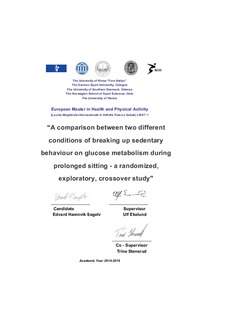| dc.contributor.author | Sagelv, Edvard Hamnvik | |
| dc.date.accessioned | 2016-08-22T12:14:54Z | |
| dc.date.available | 2016-08-22T12:14:54Z | |
| dc.date.issued | 2016-08-22 | |
| dc.identifier.uri | http://hdl.handle.net/11250/2400404 | |
| dc.description | Masteroppgave - Norges idrettshøgskole, 2016 | nb_NO |
| dc.description.abstract | Introduction: Sedentary behaviour is suggested a risk factor for various health outcomes,
independent of the amount of subcomponents of physical activity. The majority of evidence is
obtained from observational studies, making it difficult to rule out if associations are
explained by confounding and/or reverse causation. Experimental studies have until now been
limited by examining the effect of breaking up sedentary behaviour by bouts of exercise.
There is currently paucity of data comparing frequent breaks of sedentary time with one
single long bout of exercise in an iso-caloric design. Methods: 12 healthy adults were
recruited to visit the Norwegian School of Sport Sciences to undergo three different
conditions in randomized order; 1) six hours of sitting; 2) six hours of sitting, with breaks of
running on a treadmill for five minutes at 70 % of maximal oxygen uptake (VO2max) each
hour. In total for 30 minutes; 3) continuous running on a treadmill for 30 minutes at 70 % of
VO2max, followed by five hours and 30 minutes of sitting. For each condition, participants
arrived after an overnight fast for an initial fasting blood sample followed by a standardized
meal approximately 15 minutes after arrival consisting 646 kilocalories. Blood samples were
collected and blood pressure measured every hour. Maximal aerobic capacity was assessed
using indirect calorimetry and the running speed equivalent to 70 % of VO2max was
determined by extrapolation following a submaximal steady state exercise test prior to the
experiment. Each condition was separated by a 6-day wash-out period. Results: Six out of 12
participants completed all conditions. Analyses were performed as both per protocol (PP) and
intention to treat (ITT). Regardless of analyses being PP or ITT, there were no differences in
insulin, glucose and triglyceride total and incremental area under curve, and one-hour
postprandial insulin and glucose concentration, across conditions. Conclusion: There is no
effect of either breaking up sedentary behaviour each hour or performing 30 minutes of
vigorous physical activity in one bout compared with prolonged sitting for six hours on
glucose and lipid metabolism. | nb_NO |
| dc.language.iso | eng | nb_NO |
| dc.subject | nih | nb_NO |
| dc.subject | masteroppgaver | nb_NO |
| dc.title | A comparison between two different conditions of breaking up sedentary behaviour on glucose metabolism during prolonged sitting: a randomized, exploratory, crossover study | nb_NO |
| dc.type | Master thesis | nb_NO |
| dc.description.localcode | Seksjon for idrettsmedisinske fag / Department of Sports Medicine | nb_NO |
